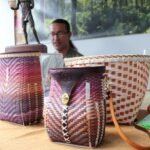
Suzann Victor, She Is Closer Than You Think, 2019, acrylic on canvas, acrylic frame and lenses, 202 x 202 x 15 cm
Photo courtesy of Gajah Gallery
For Krystina Lyon, collecting art is as much about connection as it is about curation. The art historian has spent decades immersed in Southeast Asia’s cultural landscape, building a collection that champions the voices of women artists and the region’s rising stars. With a master’s thesis on women’s art collectives and a passion for practices that explore identity, history, and community, Lyon has become a sharp-eyed supporter of artists whose stories deserve a global stage. In this conversation, she reveals the artists she is most drawn to, the importance of regional art fairs, and why supporting Southeast Asian art is not just vital for the region’s cultural infrastructure but also for enriching global artistic narratives.
Who are the artists that you’re most interested in?
I am laser focused on Southeast Asian contemporary women artists, both emerging and established. With a MA thesis on women’s art collectives, I am always interested in artists whose practices explore themes like colonial history from a gendered perspective, representation of women, female identity, migration, post-colonial narratives and community-based practice. Artists who address these issues such as Suzann Victor, Citra Sasmita, Octora and Eisa Jocson are amongst many I am familiar with.
Do regional art fairs have a role to play?
Regional art fairs are an important part in the continued development of local art ecosystems, and not just in Singapore. They provide solid platforms to showcase regional talent alongside international names, as well as foster important connections between artists, collectors and galleries. These fairs are foremost commercial entities, but they help elevate cultural narratives and introduce new audiences to a plethora of different voices and practices from the region.
Installation view of Citra Sasmita, Timur Merah Project: The Embrace of My Motherland, 2019, as part of the Biennale Jogja XV in Yogyakarta in 2019
Photo courtesy of Citra Sasmita
What are your thoughts on Art SG art fair in Singapore? Does Singapore have its place as an arts hub for the region?
Art SG is less overwhelming in size than Art Basel Hong Kong and offers a more balanced mix of Southeast Asian and international artists. Art Basel Hong Kong tends to focus more on artists from China and North Asia. Art SG has effectively filled the vacuum left by Art Stage’s demise in 2019, playing a pivotal role in energizing Singapore’s art ecosystem. It provides an opportunity to rediscover familiar artists and galleries in the region, such as Sinta Tantra represented by ISA Gallery in Jakarta, Tulip Duong from Vietnamese gallery CUC, Indonesian artist Yunizar and his sculptures from Gajah Gallery’s foundry in Yogyakarta, and Pinaree Sanpitak from Ames Yavuz, as well as new to me international galleries.
Singapore’s strategic location and robust service infrastructure positions it as a promising arts hub, although practical hurdles such as the GST payable on artworks that remain in Singapore are a handicap. When I bought an artwork from a Vietnamese gallery, I could not take possession of it following the end of the fair. It had to return to Vietnam and be shipped back to Singapore, as it was on a temporary import licence. That artwork has more air miles than I do! Despite these challenges, Art SG and its predecessors have drawn attention to Singapore’s efforts to cultivate a vibrant art scene. As well as the large art institutions such as National Gallery and Singapore Art Museum, the number of galleries and art events at the grassroots level has increased and contributed much to a dynamic local art scene.
What is the potential for development of Southeast Asian contemporary art and its rising stars?
The potential for development of Southeast Asia contemporary art is great, as there is still a lack of exposure of the artists from this region in more developed art worlds. Galleries, institutions, biennials and art fairs play an important role in bridging the gaps of knowledge about the regional art scene for collectors and visitors.
Phi Phi Oanh, Pro Se 7, 2016-2017, Son Ta (Vietnamese natural lacquer) with gold, silver, aluminum metals and stone pigments on wood, H18.8 x W24.2 x D1.3 cm
Photo courtesy of the artist and FOST Gallery
Why does Southeast Asian art need to be supported?
Southeast Asian art needs to be supported for many reasons. There is a large mixture of cultures, religions, histories and experiences that are interesting to audiences beyond the region. For instance, the region’s huge tropical forests, coastlines, maritime boundaries, precolonial histories and diverse religions provide a richness that inspire and influence its contemporary artists. Local art environments in the region often struggle for recognition and infrastructure due to inconsistent government support, and the art sector is frequently overlooked and underfunded. Supporting Southeast Asian art not only enriches global conversations, but also strengthens the region’s cultural infrastructure by nurturing and spotlighting the abundance of homegrown talent.
Why have you chosen to focus on collecting Singaporean and Southeast Asian art?
Having spent half of my life in Southeast Asia—growing up in Manila and residing in Singapore for the past 22 years—I feel deeply connected to the region. Completing a MA in Southeast Asian art histories further deepened my understanding and passion for the art practices and themes explored here. It is an exciting time to collect local artists from the region as collectors wake up to the accessibility and affordability of regional artists. I enjoy meeting rising stars like Citra Sasmita, who is garnering much global interest. She had her first solo exhibition at the Barbican in January 2025. It has been breathtaking watching her growth. I was lucky to see her work at the São Paulo Biennial, for instance. Over and over again, she is invited to participate in important biennials. She is represented by Audrey Yeo at Yeo Workshop. Also compelling is the work of Filipina artist Yeo Kaa represented by Ames Yavuz, Yee I-Lann who is with Silverlens and Vietnamese artist Phi Phi Oanh at FOST Gallery, represented by Stephanie Fong.









